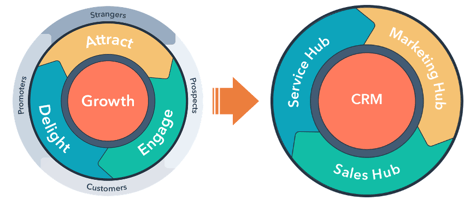Ask most business people what CRM means and they will confidently reply, "Customer Relationship Management" (and then likely add "Duh!")
But then ask them what they use their CRM for and their answers become more revealing. Marketers say "well, it's the email database where we store our contacts for our quarterly newsletter." Sales people roll their eyes and say "its where my boss makes me enter my forecast for my, so called, pipeline of deals" and service people look at you quizzically and say "Uhh, well that's marketing's bag I think, we have our own help desk system for looking after customers."
Ohh dear...
CRM should mean exactly what it says on the tin; a system for recording, documenting and managing the entire, lifelong relationship between your organisation and its most important people, its customers.
Each of the three letters are important in their own right, bolt them together and they are the rock solid foundation that must sit at the heart of your revenue generation engine.
C: Customer
Your CRM must capture and record data each and every stage of the journey a customer goes through across the full lifecycle
- from a complete stranger who has a problem and is looking for someone to help them fix it,
- to someone who realises your firm might just be able to help,
- to someone whose fully engaged in evaluating your firm's solution,
- to a new customer who decides your solution should solve their problem,
- to a customer who has, over time, seen real value in the solution they bought from you
- to a customer who extends and deepens the use of your solutions because they trust you
- to someone who is delighted to recommend you and advocate for you to their peers
R: Relationship
It must no longer be leads = marketing, prospects = sales, customers = service, three independent silos of data and insight and only loosely aligned teams.
Customers have dozens, often hundreds, occasionally thousands of interactions and touch points with your organisation across their lifetime interacting with you. Whether it's pre-sales with your social channels, emails and sales team outreach or once a customer with your onboarding team, or your account manager querying an invoice or looking for a license upgrade, your technical support team helping them fix a problem or perhaps with your customer advocacy team looking for a testimonial or referral.
All of these interactions, not just their contact data, that defines your relationship with that specific individual customer and collectively your firm's relationship with their entire organisation. Capturing these interactions in the one place, creating "one source of the truth" is incredibly powerful, providing this insight to your customer facing folks, including dashboard reporting, is a game changer. The quality of the relationship your firm has with its customers increases dramatically.
M: Management
With clean data and a single source of the truth that documents your full relationship, your organisation can now manage that relationship in a much more complete and powerful way. You can probably already see how much better your internal processes might be if you had access to a full clean view of your customers' relationship with you and a better, coordinated approach to deal with customers across your marketing sales and service teams. Here are just three ways a full understanding of your customer might change your existing processes:
- Getting out in front of a dissatisfied customer and dealing with their issue far in advance of contract renegotiations via a structured NPS program.
- Unearthing opportunities earlier for upselling and/or cross selling solutions
- Building a formal advocacy program. Using delighted customers as a source of referrals.
There is also a ton of well documented evidence of the positive effect on your revenue growth rate (higher conversions and lower costs) of an integrated CRM system:
- Lower non renewal/lost customer rates
- Increased lifetime spend. More dollars spent over a greater time
- Better marketing and sales conversion rates
- Higher referral rates from existing customers
- Higher customer satisfaction scores
Required features:
If you are taking an integrated approach to CRM, the product you use must have a set of features that marketing, sales and service teams are going to need to do their jobs.
Note: We advise many of our clients to start small and then roll out CRM across their organisation over time. But functionally future proofing your investment is smart, so here is a checklist of features you should look for that you can use as a starting point.
| Marketing | Sales | Service |
| Email marketing | Pipeline management | Help desk ticketing |
| Forms for lead capture | Deal Tracking |
Live chat |
| A contact's website activity | Reporting dashboards | ChatBots |
| Reporting dashboards | Company Insights | FAQs |
| Contact management | Contact management | Email templates |
| Lead generation | Call tracking | Open/Closed ticket reporting |
| Meeting scheduler | ||
| Gmail & Outlook integration | ||
| Task and activity lists |

At g2m we always start our work by ensuring a robust, built for purpose CRM is sitting at the heart of the HubSpot software which we are configuring, installing, building and training for our customers. We wouldn't do it any other way.
Your goal must be to create "one source of the truth" for all the information you have about your customers.
If you are rethinking your current approach to CRM, we'd be happy to have a no-commitment up front discussion. Or if you are ready to jump right in and start experimenting, just sign up to to HubSpot's entirely free CRM.

